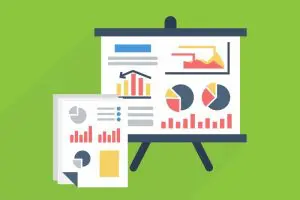There is no one-design-fits-all solution for infographic creation. A well-designed infographic can make complex and even dry information easier to read and understand. So what are the best types of infographics to convey your messages or data to an audience? That depends on the kind of data available, where you post infographics, and your brand’s goal in creating them.

(kreatikar/Pixabay)
9 Popular Infographic Types
1. Statistical
Statistical infographics include various charts and graphs to help visualize statistics. They may include pie charts, bar graphs, pictograms, etc. Statistical infographics help back up arguments with data and present data collected from multiple sources. When used correctly, the visuals will tell a story behind the data.
To create effective statistical infographics, first, focus on the story you want to tell. Be sure that your title and headings reflect the primary messaging. From here, you may emphasize significant numbers or ideas in your charts and graphs through eye-catching fonts, icons, and colors.
2. Informational
Informational infographics are best for introducing new concepts and for giving topic overviews. While an infographic is a visual content piece, informational infographics will include more text and fewer charts, graphs, and other imagery. The appearance, however, is enhanced by adding color, icons, and careful formatting.
For effective informational infographics, break your message into distinct sections with descriptive headers. Number each section for the most accessible information flow. You may lay out information chronologically, or a circular design might work when designing with facts that have no set order. Alternating colors or icons may make the messaging easier to follow.
3. Location
Using location or geographic infographics can easily represent trends across a geographical region. Location infographics usually include a map indicating location-specific data or demographic information.
Effective geographic or location infographics need clearly labeled location points. Use color coding or distinct icons to help readers visualize the data.
4. Comparison
Comparison infographics are useful for visually demonstrating comparisons between products, brands, ideas, and other topics. They may also compare and contrast opposing objects or ideas to find similarities.
Effective comparison infographic design will be split down the middle with options on either side. Each option can be further emphasized and set apart using contrasting colors, imagery, and icons.
5. List
List infographics, like informational infographics, rely more on text than charts and graphs. List infographics are helpful when sharing a list of resources, examples, or tips. Turning lists into infographics is about making them more eye-catching and visually appealing. Your audience is more likely to share infographics than a written list.
For effective list infographics, number each of the points in your list. It is also helpful to use different colors and icons for each point, making them stand out. To draw attention further, consider using unconventional shapes, such as laying each point out in a circle.
6. Hierarchical
Hierarchical infographics present information organized on different levels. The most common format for these is a pyramid shape.
Effective hierarchical infographics are typically laid out with data from greatest to least, whether that relates to levels of difficulty, importance, or abundance. Hierarchical charts can also demonstrate a chain of command or parts of a whole.
7. Process
Process infographics often show step-by-step processes. These are best for providing an overview or summary of a process. Process infographics should highlight and clarify each individual step.
Creating an effective process infographic will include numbering each step in the order they happen. It would help if you also had other visual clues, such as arrows, to indicate the flow of the process and the infographic. Making sure headers are in different vibrant colors will help to break up the design and allow the infographic to flow better.
8. Timeline
Timeline infographics tell a chronological story or show the evolution over time. Timelines can be used to demonstrate historical information, highlight important dates, or tell your brand’s story.
For effective timeline infographics, visual elements such as icons, lines separating historical points, imagery, labels, and descriptive headers help to distinguish points and explain the flow over time. Laying out the design in one line connecting each point may be the most effective option. Keep point text descriptions brief and emphasize only the most critical elements.
9. Resume
Resume infographics can set your work resume apart from the competition. While most employers may still want to see a traditional resume, turning your educational and work experience into a visually compelling infographic could work out great in an interview or on your personal website.
For effective resume infographics, the header must reflect your personality or brand. Turning a resume into an infographic is mostly about visually embellishing important information. Consider adding decorative borders and stand-out section headers. Design icons that reflect your primary industry or occupation. Add logos from companies you’ve worked for. You may even add graphs or charts to represent the growth and value you’ve added throughout your career.
While there are many different types of infographics, the right type to represent your brand and messaging depends on the kind of data you are showcasing and your marketing goals. Infographics should be part of a business’s marketing strategy to help build brand awareness, educate your audience, and increase website traffic and SEO.
